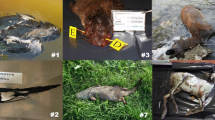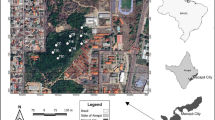Abstract
The underlying cause of death of a group of New England mink, which died in 1969 to 1970 was explored. PCB and chlorinated hydrocarbon pesticide levels were measured. Aroclor 1254 levels in these mink were elevated 73 fold over levels in healthy mink in 1974. DDT levels were elevated 5 times and DDE 3 times over those control animals. Gross pathology revealed lesions of the lungs, liver and kidneys. These lesions were confirmed microscopically. The lungs of the New England mink showed inflammation and congestion. Areas of inflammation were also present in the liver. Massive areas of necrosis were seen in the kidneys, both in the medullary and cortical areas. Kidney involvement was greater than any other organ. P.A.S. positive material was seen in each of these organs with the kidneys showing largest amounts of this material. Since the New England mink did not show lesions of the G.I. tract, did not exhibit fatty degeneration of the liver, which PCB toxicity is known to induce in mink and because they showed areas of congestion, inflammation and positive P.A.S. material, PCB's were not considered the toxic agent. However, fungus or bacterial infection might be the causative agent.
Similar content being viewed by others
References
Aulerich, R.J., R.K. Ringer, and S. Iwamoto: Reproductive failure and mortality in mink fed on Great Lakes fish. J. Reprod. Fert. Suppl.19, 365 (1973).
Cantarow, A., and B. Schepartz:Biochemistry (Third Edition), p. 184. Philadelphia: W.B. Saunders (1962).
Ender, F., and L. Ceh: Conditions and chemical reaction mechanisms by which nitrosamines may be formed in biological products with reference to their possible occurrence in food products. A. für Lebensmittel-Untersuchung und Forschung.145, 133 (1971).
Griffith, F.D., and R. V. Blanke: Microcoulometric determination of organochlorine pesticides in human blood. J. Ass. Offic. Agr. Chem.57, 595 (1974).
Hartsough, G.R.: Great Lakes fish now suspect as mink food. Amer. Fur Breed.38, 25 (1965).
Hartsough, G.R., and G.R. Gorham: Aleutian disease in mink. Nat. Fur News.28, 10 (1956).
Hoopengarner, R., A. Samuel, and D. Krause: Polychlorinated biphenyl interaction with tissue culture cells. Env. Health Perspectives.1, 155 (1972).
Lichtenstein, E.P.: PCB's and interactions with insecticides. Env. Health Perspectives.1, 151 (1972).
Pesticide Analytical Manual:Food and Drug Administration. Vol. 1 (1972).
Vos, J.G.: Toxicology of PCB's for mammals and for birds. Env. Health Perspectives.1, 105 (1972).
Vos, J.G., J.H. Koeman, H.L. VanDer Maas, M.C. Ten Noever De Brauw, and R.H. De Vos: Identification and toxicological evaluation of chlorinated dibenzofuran and chlorinated naphthalene in two commercial polychlorinated biphenyls. Food Cosmet. Toxicol.8, 625 (1970).
Vos, J.G., and Th. Roy: Immunosuppressive activity of a polychlorinated biphenyl preparation on the humoral immune response in guinea pigs. Toxicol. Appl. Pharmacol. (in press).
Author information
Authors and Affiliations
Rights and permissions
About this article
Cite this article
Friedman, M.A., Griffith, F.D. & Woods, S. Pathologic analysis of mink mortality in New England mink. Arch. Environ. Contam. Toxicol. 5, 457–469 (1977). https://doi.org/10.1007/BF02220925
Issue Date:
DOI: https://doi.org/10.1007/BF02220925




